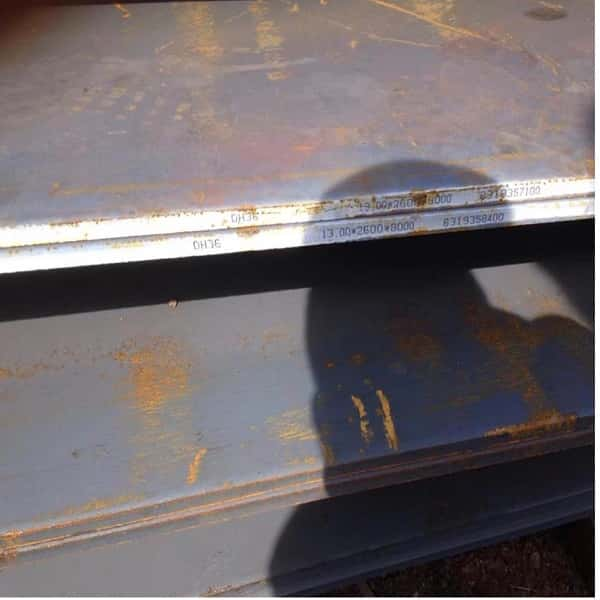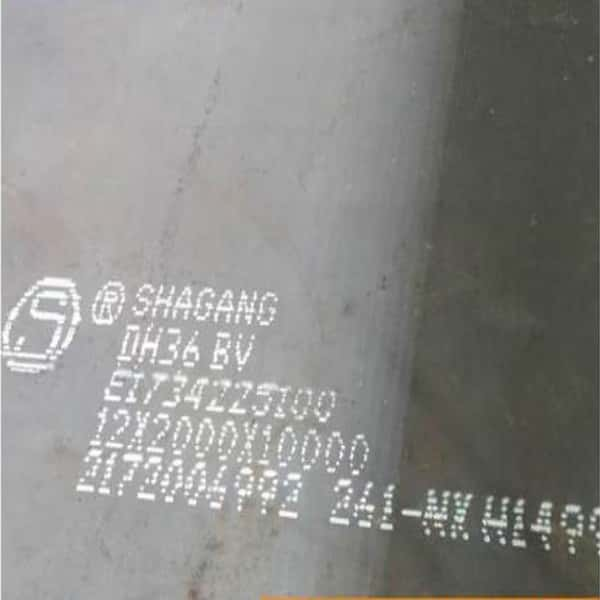Top Metal Manufacturer Supply ABS approved Marine Steel Plate with different sizes. ABS A and ABS B are types of structural steel that are used for shipbuilding. These steel grades are defined as ordinary strength and these grades are certified by the American Bureau of Shipping (ABS) so that they can be used in shipbuilding.
AH36, DH36, EH36 steel plate for Shipbuilding
Shipbuilding steel plate refers to the carbon and alloy steel plate used in offshore and marine constructions, common grades are A, B, D, E, AH32/36/40, DH32/36/40, and EH32/36/40 which ranged from different strength. The plates usually used to manufacture ship hulls, bulkheads, upper decks and hatch covers for tankers, bulk carriers, container ships and LNG carriers.
AH36, DH36, EH36 Steel – Common Use High Strength Steel in Offshore & Marine
For the high strength shipbuilding plates like AH36, DH36, EH36 steel plate, they have been widely used in high stress areas of ships, comparing with general strength steel, they are offering the same strength with the smaller thickness.
Shipbuilding steel material in carbon and alloy steel, compatible with high strength, low temperature and high heat input soldering.
Grades: A, B, D, E, AH32/36/40, DH32/36/40, EH32/36/40
According to its yield strength, shipbuilding plate of can be divided into below grades:
- Grade A steel is the impact force subjected to normal temperature (20 ° C).
- Grade B steel impact force at 0 °C.
- Grade D steel impact force at -20 °C.
- Grade E steel impact force at -40 °C.
- High-strength shipbuilding steel plate can be further divided into: AH32, DH32, EH32; AH36, DH36, EH36 and AH40, DH40, EH40.
- The general grades A, B, D, and E are distinguished according to the impact temperature of the steel. The impact values of all grades of steel are the same.
- High-intensity hull structure steel preheating requirements: For all AH, DH, EH plate thickness greater than 30mm angle, butt joints, shall be preheating to 120 ~ 150 °C before welding.
- For thickness of the plate ≤ 30mm, the ambient temperature is below 5 ° C, preheated to 75 ° C; Ambient temperature below 0 ° C, preheated to 75 ~ 100 ° C.
- shipbuilding steel Chemical Composition
| Elements | C | Mn | Al | Si | P | S |
| AH32 | ≤0.18 | 0.7~1.60 | ≥0.015 | 0.10~0.50 | ≤0.04 | ≤0.04 |
| DH32 | ≤0.18 | 0.90~1.60 | ≥0.015 | 0.10~0.50 | ≤0.04 | ≤0.04 |
| EH32 | ≤0.18 | 0.90~1.60 | ≥0.015 | 0.10~0.50 | ≤0.04 | ≤0.04 |
| AH36 | ≤0.18 | 0.7~1.60 | ≥0.015 | 0.10~0.50 | ≤0.04 | ≤0.04 |
| DH36 | ≤0.18 | 0.90~1.60 | ≥0.015 | 0.10~0.50 | ≤0.04 | ≤0.04 |
| EH36 | ≤0.18 | 0.90~1.60 | ≥0.015 | 0.10~0.50 | ≤0.04 | ≤0.04 |
| shipbuilding steel plate Properties | |||||||
| Steel Grade | Thickness/mm | Yield point/ MPa | Tensile strength/ MPa | Elongation/ % | V-type impact test | ||
| Temperature/ ℃ | Average impact absorption workAkv/J | ||||||
| Vertical | Horizontal | ||||||
| A | ≤50 | ≥235 | 400~490 | ≥22 | – | – | – |
| B | ≤50 | ≥235 | 400~490 | ≥22 | 0 | ≥27 | ≥20 |
| D | ≤50 | ≥235 | 400~490 | ≥22 | -10 | ≥27 | ≥20 |
| E | ≤50 | ≥235 | 400~490 | ≥22 | -40 | ≥27 | ≥20 |
| AH32 | ≤50 | ≥315 | 440~590 | ≥22 | 0 | ≥31 | ≥22 |
| DH32 | ≤50 | ≥315 | 440~590 | ≥22 | -20 | ≥31 | ≥22 |
| EH32 | ≤50 | ≥315 | 440~590 | ≥22 | -40 | ≥31 | ≥22 |
| AH36 | ≤50 | ≥355 | 490~620 | ≥22 | 0 | ≥34 | ≥24 |
| DH36 | ≤50 | ≥355 | 490~620 | ≥22 | -20 | ≥34 | ≥24 |
| EH36 | ≤50 | ≥355 | 490~620 | ≥22 | -40 | ≥34 | ≥24 |





